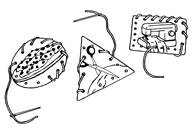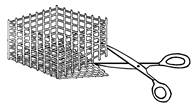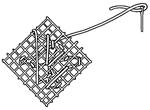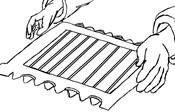renewal cycles. Complete
some now & some later.
and Get 25% off
the Total price!
Buy 3 Courses
and Get 30% off
the Total price!
Buy 4 Courses
and Get 35% off
the Total price!
| Create Account | Login | |

Section 21
Lacing Cards & Yarn Weaving
Table of Contents | NCCAP/NCTRC CE Booklet
 The idea of Lacing Cards evolved from the fact that many residents used to sew or did some form of needle work. However, limitation in the areas of eye sight, hand mobility, and attention span made the pursuit of these activities impossible. So I came up with the idea of Lacing Cards based upon an elementary school activity. It's a way of providing for your resident who perhaps used to sew and may be motivated by the thought of performing a sewing-like activity again.
The idea of Lacing Cards evolved from the fact that many residents used to sew or did some form of needle work. However, limitation in the areas of eye sight, hand mobility, and attention span made the pursuit of these activities impossible. So I came up with the idea of Lacing Cards based upon an elementary school activity. It's a way of providing for your resident who perhaps used to sew and may be motivated by the thought of performing a sewing-like activity again.
Today, of course, you can buy sets of Lacing Cards and perhaps you already have. But if you do, or have already purchased them, my guess is you will be less likely to leave an item purchased from you Activity Budget in a residents room; than one you have made for NO COST. Get it? Convinced?
To make your set of Lacing Cards, paste magazine pictures onto corrugated cardboard. Then cut them into, for example, circular, triangular and rectangular shapes. I find around 4" to 7" is a good size for a resident to hold. In order to make the holes through which the yarn goes around the outside edge of the Lacing Card, I find a new hole or paper punch makes the job much easier. Notice I said a new paper punch. Paper punches aren't very expensive at an office supply store. It might be worth your while to buy more than one, since punching through the cardboard tends to dull the punch quickly.
Wrap a short piece of Scotch tape around the end of the yarn to facilitate pushing the yarn through the hole. To start the yarn, you pull it through a hole and tie it at one end, to prevent the yarn from slipping through when a resident first starts to use a Lacing Card. I have had a lot of luck getting early and middle stage Alzheimer's residents to lace a Lacing Card. I feel this success may be due to the fact that female residents can relate this activity to sewing, as mentioned earlier. The importance is not in producing a nice, neat lap stitch pattern around the outside edge, but, repeating once again, the important concept is to provide your resident with a successful experience. J Perhaps after you help your resident guide their yarn through the hole, you say, “Martha, good, great, can you pull the yarn through the hole?”
The last track of the DVD has slides and commentary regarding this process of pushing the yarn through the hole.
| Goal: To push the yarn though two holes on a lacing card independently once started… |
Goal: To do a Lacing Card with physical assistance and encouragement… |
Goal: To do a Lacing Card independently once started… |
Observe and Assess!
I interviewed a resident once who could not stabilize the Lacing Card with her left hand. However, she had enough mental ability and movement in her right hand to do a Lacing Card. To facilitate stabilization, you might C-clamp the Lacing Card onto the edge of the over-the-bed-table or work surface. As with Magazine Folding, come back to her a few minutes late; after working with another resident; and rotate the Lacing Card so that the portion that hadn’t been laced is the part hanging off the edge of the over-the-bed-table. This particular resident was not alert enough to be aware that she was lacing the same Card every day. So when she would lace the Card or part of it I would say, “Thank you very much, that really helped me out.” I then would unlace the card when I was out of her view.
Are Lacing Cards non product-producing? You bet! Nonsensical? Sure, some would think so. But… you guessed it! She had a feeling of pride in her work, success, and accomplishment; and I feel this improved the quality of her life, which as you know by now is what the Alzheimer’s Series is all about. You see, I keep repeating these same key principles over and over again. I want to ingrain them so deeply in your thought process that by the end of these courses the core concepts are not only something that you know and understand, but believe in their implementation.
You believe so much in the implementation of these simple activities for the low functioning that you take action and implement them with any and all appropriate residents throughout your facility. Perhaps you will so thoroughly believe in the ideas here that you will get to the point where you can hardly wait to interview your next new admission to see what idea or ideas will work with him or her. Am I asking for too much? Too pie-in-the-sky? That's up to you to decide. As with all the projects in these courses, as you deem appropriate, leave the project in the residents room, with an explanatory label enabling all to use, who come into contact with that resident.
Residents with whom to try Lacing Cards
| Resident | Who will gather materials and/or construct project? |
Staff /Volunteer to work with resident? When? |
|
|
|
|
|
|
Progress Note: See page 7 for details regarding this four-part implementation procedure, which can become the basis of a Progress Note, stating “When I tried Lacing Cards with __________________, the following occurred… |
1. Observation: |
2. Assessment: |
3. Creativity: |
4. Sensitivity: |
Culture Change Implementation: Place Lacing Cards in labeled Activity Project Bag left in resident’s room for CNA, volunteer, etc. use.
Weaving on a Basket
(The last track of the DVD contains slide(s) illustrating implementation of this activity.)


Needle Point made Easy
An adaptation of Lacing Cards is to make a simplified Needle Point for the resident. If your resident has a hard time finding the holes punched around the edge of the Lacing Card, in order to increase his or her chances of success, you might try this adapted of a Needle Point activity. Sometimes strawberries or cherry tomatoes come in a plastic basket. Your resident then can weave around the outside or through the center or just in a miscellaneous design with the yarn. Residents can find success in weaving randomly around the sides and bottom of the basket. Or try cutting the bottom out of a strawberry or cherry tomato basket. The amount of stiffness in your resident's hands will determine whether the basket or the flat square bottom is easier for them to hold. The implementation of Weaving on Basket is similar to the implementation of Lacing Cards. Assess residents’ ability to push and pull the yarn through the holes using a plastic needle or scotch tape wrapped around the end of the yarn to provide stiffness.
If you can’t obtain plastic baskets from the grocery for free, craft stores of course have plastic grids available for needlepoint and rug-making. Thus, you can vary the difficulty by providing the resident with a grid of smaller or wider hole sizes. Of course, then the project is placed in a labeled Activity Project Bag and left in the resident’s room, available for all staff, visitors, etc.
| Goal: To pull yarn through a hole in a simple Yarn Weaving project with physical assistance… |
Goal: To push yarn up through the hole in a simple Yarn Weaving Project… |
Goal: After demonstration, to pull yarn through three holes in a simple Yarn Weaving project… |
Goal: After demonstration, to pull yarn through five holes in a simple Yarn Weaving project… |
Residents with whom to try Yarn Weaving on a Basket
| Resident | Who will gather materials and/or construct project? |
Staff /Volunteer to work with resident? When? |
|
|
|
|
|
|
Progress Note: See page 7 for details regarding this four-part implementation procedure, which can become the basis of a Progress Note, stating “When I tried Yarn Weaving on a Basket with _________________, the following occurred… |
1. Observation: |
2. Assessment: |
3. Creativity: |
4. Sensitivity: |
Culture Change Implementation: Place Weaving on a Basket in labeled Activity Project Bag left in resident’s room for CNA, etc. use.
Yarn Weaving on a Loom
A more difficult form of weaving than Yarn Weaving on a Basket is Yarn Weaving on a Loom. To construct the loom, cut a piece of corrugated cardboard approximately twelve inches by twelve inches. If you are thinking, “why take the time to make a loom out of cardboard when I can buy one?” you probably know the answer by now is that no cost items are more likely to be left in residents’ rooms. Agree?
 After you have cut your 12” x 12” square, cut a square out of the center, leaving a 1” to 1-1/2” border around the edge. Cut seven or eight 1” V’s at opposite ends of the loom. Wrap the yarn around the one-inch V’s as indicated in the diagram. Affix ends of this yarn with a knot, or Scotch tape. The resident then weaves from left to right, and right to left across the vertical yarn lines you have created.
After you have cut your 12” x 12” square, cut a square out of the center, leaving a 1” to 1-1/2” border around the edge. Cut seven or eight 1” V’s at opposite ends of the loom. Wrap the yarn around the one-inch V’s as indicated in the diagram. Affix ends of this yarn with a knot, or Scotch tape. The resident then weaves from left to right, and right to left across the vertical yarn lines you have created.
Sensitivity to “Errors”
Residents of this level will make many mistakes. So don’t lose sight of the fact that you are trying to provide them with a situation, circumstance, and task for which you can say sincerely, “Good, great, you did a good job.” Of course the goal is not to have a neatly completed craft project. Think of this as a hand exercise, a means by which your Esther is moving her fingers to retain the ability she has. If Esther makes a mistake, as she will, and states, “Oh gosh, this looks terrible!” a good response is, “I love that color of blue yarn you are using! I think the pattern you are making really looks good. Try another row, I am anxious to see how that one is going to look.”
Thus, you place yourself in the role of being an encourager, rather than an enforcer of exactness.
If you have an analytical type of personality, this might be difficult for you. However, if you have more of an amiable type of personality, you will probably be wondering why I am taking so much space in the Manual telling you how to “be ok with” residents’ Yarn Weaving that is not symmetrically perfect.
Goal: To do Yarn Weaving on a loom with partial physical assistance… |
Goal: To weave one row on the loom independently after being assisted with one row… |
Goal: To do Yarn Weaving on a loom independently once started… |
Residents with whom to try Yarn Weaving on a Loom
| Resident | Who will gather materials and/or construct project? |
Staff /Volunteer to work with resident? When? |
|
|
|
|
|
|
Progress Note: See page 7 for details regarding this four-part implementation procedure, which can become the basis of a Progress Note, stating “When I tried Yarn Weaving on a Loom with _________________, the following occurred… |
1. Observation: |
2. Assessment: |
3. Creativity: |
4. Sensitivity: |
Culture Change Implementation: Place Weaving on a Loom in labeled Activity Project Bag left in resident’s room for CNA, etc. use.
NCCAP/NCTRC CE Booklet
Forward to Section 22
Back to Section 20
Table of Contents
Top


